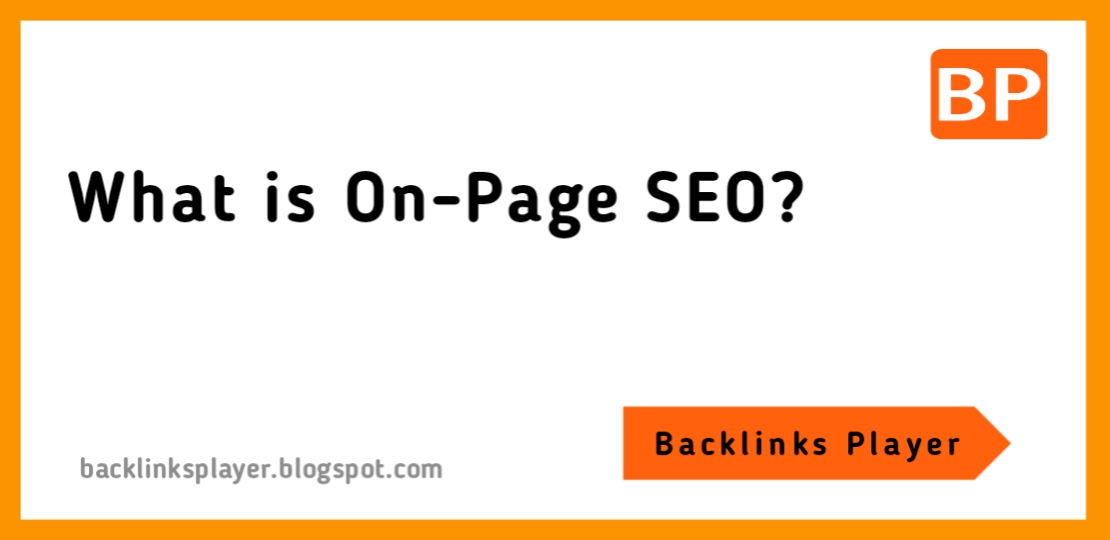SEO is a way to get into the global information sharing
arena. There are many ways of building SEO-Friendly websites, from simple
copywriting that gets you in bed with publishers to more sophisticated tools
designed by some companies for web developers.
What is On-Page SEO?
If you want to make a user-friendly and better Website which image is compatible with its content, and get organized place on huge Search
Engines like Google, Yahoo. Then you have to use SEO for your website, and
mainly On-Page SEO.
If you want to make a user-friendly and better Website whose
image is compatible with its content, and get organized place on huge Search
Engines like Google, Yahoo. Then you have to use SEO for your website, and
mainly On-Page SEO. SEO is the way of increase the value of any Blog/Website on
a Search Engine. On-Page SEO is a great thing for your website. Comparatively,
On-Page SEO is actions taken inside of your website to influence SEO.
On-page SEO is important for any website because it helps
search engines identify what your content is about;
Google wants to obtain out how consistent content is to
keywords. It requires learning websites in the meaning of what people are
exploring for;
On-page SEO is about showing Google what it’s crawling,
indexing and ranking. It’s showing them what it should look like on SERPs.
How to Improve On-Page SEO?
Importance of Metadata
Metadata is one of the most important concepts of on-page
SEO. When building your website, each page includes a space between the
<head> tags to include metadata or data on your page's content.
If you have a CMS website developed by UMC, the web team
will already fill in this data for you. Still, as your site grows over time,
you need to analyze and update the metadata.
That's why, no matter how valuable your website is, you'll
need to update its metadata over time.
Improve Alt (alt) Tag
Always add your image and video media using <alt> tags
or Alternative text representations. If an image doesn’t load properly, this
text will show up in its position. <alt> Tag will give the user a greater
opinion of what was assumed to be there and how the layout would typically
appear.
Alt tags are designed for visually spoiled users. Programs
like screen-readers will read the content of a webpage out loud. <alt>
Tag is the primary way of presenting context to help someone experience the
appearance of the site – even if they can’t physically see it for themselves.
Post Regularly
I always say that if your website is getting regular traffic
and Google AdSense is also there, Still, you need to keep posting content
regularly because it increases the engagement of your website, traffic comes
and Google also feels that This website is user-friendly.
Create content that is beautiful, high-quality,
well-written, and attractive.
Build an SEO-optimized landing page for your blog that
utilizes multiple links to your site to your built-in SEO software!
Receive greater visibility and gain readers for your
content.
Improve Loading Speed
Size your images appropriately –
We usually seen clients make the mistake of uploading
full-sized, 12-megapixel images out resizing them first.
Don’t upload a 6000-pixel full image if it's going to being
display at 500 pixels. Make sure that photos are size according to the
parameters of the picture.
Stick to JPG when possible –
JPG is a reduced image format that maintains the probity of
the image without consuming unnecessary space. So for the vast majority of
applications, JPG is fancied. Use PNG
when clarity is required.
Compress all Video –
High-definition video has the potential to be a significant
speed hog. Be sure to reduce each video using a video compression tool such as
Handbrake.
Embed Using a 3rd party Video Hosting Platform –
It’s also a good idea to embed video using a 3rd-party video
hosting platform such as Vimeo or Wistia to reduce the impact on your hosting
server’s bandwidth.
Leverage a caching, page speed plugin -
Many parts affect website page load speed, many are simply
behind the expertise of the average marketer, and many helpful plugins or
modules can assist with the technical heavy lifting.
Page saving is another way to help improve your page load
time. A cached web page loads much quicker—while minimizing server load by up
to 80%. WordPress users can easily install one of the many popular pages
caching plugins.
A robust page activity solution for WordPress websites like
WP Rocket, which can handle page caching, as well as many other page-speed
optimization techniques such as:
Enabling browser caching
LazyLoading images and video
Minifying resources (HTML, CSS, JS)
Removing query strings from static resources
Combining files (Google fonts, CSS, JS)
Optimizing the database
Loading CSS files asynchronously
Loading JS files deferred
A Way to Save Time in Your SEO Efforts
Let's say you're off the coast of America, in the middle of
the rising sun over the Pacific. You can see that it is getting dark outside,
and the sky is grayish-beige. A thunderstorm is pointing your way over East
Africa, blowing your most recent—yet most original—material behind the frame as
the wind blows into your ears.
If you're like most web design writers, you'll have current
content suggestions with the names (and sub-tweets) you've been reading side by
side. It will probably be suppressed not knowing that you can slightly tweak
the content.
Gain a spot on the backend of an algorithm that will allow
your content to reach a greater audience than otherwise, your site might not be
capable of without it.






0 Comments
Thank You So Much!!!